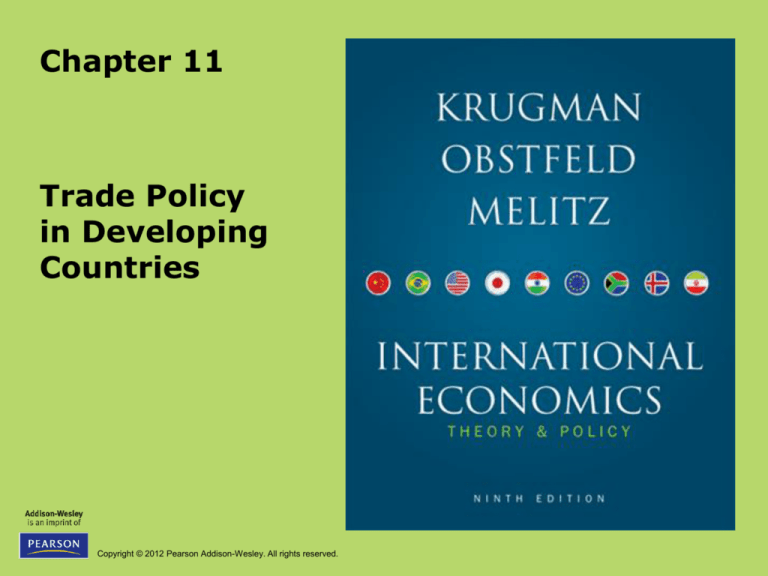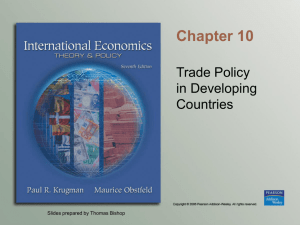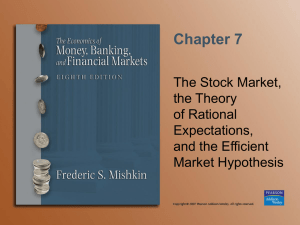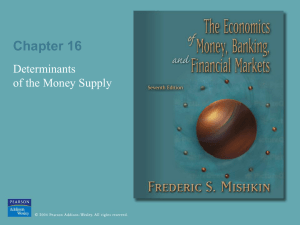
Chapter 11
Trade Policy
in Developing
Countries
Copyright © 2012 Pearson Addison-Wesley. All rights reserved.
Preview
• Import-substituting industrialization
• Trade liberalization since 1985
• Trade and growth: takeoff in Asia
Copyright © 2012 Pearson Addison-Wesley. All rights reserved.
11-2
Introduction
• Which countries are “developing countries”?
• The term “developing countries” does not have a
precise definition, but it is a name given to many
low- and middle-income countries.
Copyright © 2012 Pearson Addison-Wesley. All rights reserved.
11-3
Table 11-1: Gross Domestic Product Per
Capita, 2009 (dollars)
Copyright © 2012 Pearson Addison-Wesley. All rights reserved.
11-4
Import-Substituting
Industrialization
• Import-substituting industrialization was a trade
policy adopted by many low- and middle-income
countries before the 1980s.
• The policy aimed to encourage domestic industries
by limiting competing imports.
Copyright © 2012 Pearson Addison-Wesley. All rights reserved.
11-5
Table 11-2: Effective Protection of
Manufacturing in Some Developing Countries
(percent)
Copyright © 2012 Pearson Addison-Wesley. All rights reserved.
11-6
Import-Substituting Industrialization
(cont.)
• The principal justification of this policy was/is the
infant industry argument:
– Countries may have a potential comparative advantage in
some industries, but these industries cannot initially
compete with well-established industries in other
countries.
– To allow these industries to establish themselves,
governments should temporarily support them until they
have grown strong enough to compete internationally.
Copyright © 2012 Pearson Addison-Wesley. All rights reserved.
11-7
Problems with the
Infant Industry Argument
1.
It may be wasteful to support industries now
that will have a comparative advantage in the
future.
2.
With protection, infant industries may never
“grow up” or become competitive.
3.
There is no justification for government
intervention unless there is a market failure that
prevents the private sector from investing in the
infant industry.
Copyright © 2012 Pearson Addison-Wesley. All rights reserved.
11-8
Infant Industries and Market
Failures
•
Two arguments for how market failures
prevent infant industries from becoming
competitive:
1. Imperfect financial asset markets
–
Because of poorly working financial laws and
markets (and more generally, a lack of property
rights), firms cannot or do not save and borrow to
invest sufficiently in their production processes.
–
If creating better functioning markets and enforcing
laws is not feasible, then high tariffs would be a
second-best policy to increase profits in new
industries, leading to more rapid growth.
Copyright © 2012 Pearson Addison-Wesley. All rights reserved.
11-9
Infant Industries
and Market Failures (cont.)
2. The problem of appropriability
–
Firms may not be able to privately appropriate the
benefits of their investment in new industries because
those benefits are public goods.
–
The knowledge created when starting an industry may
not be appropriable (may be a public good) because of a
lack of property rights.
–
If establishing a system of property rights is not
feasible, then high tariffs would be a second-best policy
to encourage growth in new industries.
Copyright © 2012 Pearson Addison-Wesley. All rights reserved.
11-10
Import-Substituting
Industrialization (cont.)
• Import-substituting industrialization in Latin
American countries worked to encourage
manufacturing industries in the 1950s and 1960s.
• But economic development, not encouraging
manufacturing, was the ultimate goal of the policy.
• Did import-substituting industrialization promote
economic development?
– No, countries adopting these policies grew more slowly
than others.
Copyright © 2012 Pearson Addison-Wesley. All rights reserved.
11-11
Import-Substituting Industrialization
(cont.)
• It appeared that the infant industry argument was
not as valid as some had initially believed.
• New industries did not become competitive despite
or because of trade restrictions.
• Import-substitution industrialization involved costs
and promoted wasteful use of resources:
– It involved complex, time-consuming regulations.
– It set high tariff rates for consumers, including firms that
needed to buy imported inputs for their products.
– It promoted inefficiently small industries.
Copyright © 2012 Pearson Addison-Wesley. All rights reserved.
11-12
Trade Liberalization
• Some low- and middle-income countries that had
relatively free trade had higher average economic
growth than those that followed import
substitution.
• By the mid-1980s, many governments had lost
faith in import substitution and began to liberalize
trade.
– Dramatic fall in tariff rates in India and Brazil, and less drastic
reductions in many other developing countries.
Copyright © 2012 Pearson Addison-Wesley. All rights reserved.
11-13
Trade Liberalization (cont.)
• Trade liberalization in developing countries
occurred along with a dramatic increase in the
volume of trade.
– The share of trade in GDP has tripled over 1970–1998,
with most of the growth happening after 1985.
– The share of manufactured goods in developing-country
exports surged, coming to dominate the exports of the
biggest developing economies.
• A number of developing countries have achieved
extraordinary growth while becoming more, not
less, open to trade.
Copyright © 2012 Pearson Addison-Wesley. All rights reserved.
11-14
Fig. 11-1: Tariff Rates in Developing
Countries
Source: World Bank.
Copyright © 2012 Pearson Addison-Wesley. All rights reserved.
11-15
Fig. 11-2: The Growth of DevelopingCountry Trade
Copyright © 2012 Pearson Addison-Wesley. All rights reserved.
11-16
Trade Liberalization (cont.)
• Has trade liberalization promoted development?
The evidence is mixed.
– Growth rates in Brazil and other Latin American countries
have been slower since trade liberalization than they were
during import-substituting industrialization.
• But unstable macroeconomic policies and financial
crises contributed to slower growth since the 1980s.
Copyright © 2012 Pearson Addison-Wesley. All rights reserved.
11-17
Trade Liberalization (cont.)
– Other countries like India have grown rapidly since
liberalizing trade in the 1980s, but it is unclear to what
degree liberalized trade contributed to growth.
– Some economists also argue that trade liberalization has
contributed to income inequality, as the Heckscher-Ohlin
model predicts.
Copyright © 2012 Pearson Addison-Wesley. All rights reserved.
11-18
Trade and Growth: Takeoff in Asia
• Instead of import substitution, several countries in
East Asia adopted trade policies that promoted
exports in targeted industries.
– Japan, Hong Kong, Taiwan, South Korea, Singapore,
Malaysia, Thailand, Indonesia, and China have experienced
rapid growth in various export sectors and rapid economic
growth in general.
Copyright © 2012 Pearson Addison-Wesley. All rights reserved.
11-19
Trade and Growth: Takeoff in Asia (cont.)
• These high-performance Asian economies generated a high
volume of exports and imports relative to total production.
• Their policy reforms were followed by a large increase in
openness, as measured by their share of exports in GDP.
• So it is possible to develop through export-oriented growth.
• However, Latin American nations such as Mexico and Brazil,
which also sharply liberalized trade and shifted toward
exports, did not see comparable economic takeoffs.
• These Latin American results suggest that other factors must
have played a crucial role in the Asian miracle.
Copyright © 2012 Pearson Addison-Wesley. All rights reserved.
11-20
Fig. 11-3: The Asian Takeoff
Source: Total Economy Database.
Copyright © 2012 Pearson Addison-Wesley. All rights reserved.
11-21
Fig. 11-4: Asia’s Surging Trade
Copyright © 2012 Pearson Addison-Wesley. All rights reserved.
11-22
Trade and Growth: Takeoff in Asia (cont.)
• It’s unclear if the high volume of exports and
imports caused rapid economic growth or was
merely correlated with rapid economic growth.
– High saving and investment rates could have led to both
rapid economic growth in general and rapid economic
growth in export sectors.
– Rapid growth in education led to high literacy and
numeracy rates important for a productive labor force.
– These nations also undertook other economic reforms.
Copyright © 2012 Pearson Addison-Wesley. All rights reserved.
11-23
Summary
1. Import-substituting industrialization aimed to
promote economic growth by restricting imports
that competed with domestic products in low- and
middle-income countries.
2. The infant industry argument says that new
industries need temporary trade protection due to
market failures:
–
imperfect asset markets that restrict saving, borrowing,
and investment in production processes
–
problems of appropriating gains from private investment
in production processes
Copyright © 2012 Pearson Addison-Wesley. All rights reserved.
11-24
Summary (cont.)
3. Import-substituting industrialization was tried
in the 1950s and 1960s but by the mid-1980s
it was abandoned for trade liberalization.
4. The effect of liberalized trade on national
welfare is still being debated.
–
Trade helped growth in some sectors, but saying that
trade caused higher overall economic growth has
attracted some skepticism.
–
Some argue that trade has caused increased income
inequality.
Copyright © 2012 Pearson Addison-Wesley. All rights reserved.
11-25
Summary (cont.)
5. Several East Asian economies adopted exportoriented instead of import-substituting
industrialization.
–
–
High export and import volumes and relatively low trade
restrictions were characteristics of this policy.
It’s unclear to what degree this policy contributed to
overall economic growth, especially since other countries
have not had similar successes.
Copyright © 2012 Pearson Addison-Wesley. All rights reserved.
11-26








